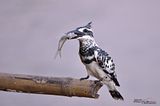January 23 saw me wandering around Sekinoe for the last time before flying back to Thailand. It was a beautiful morning with clear blue sky and nice warm morning light. I initially wanted to get some better shots of the White-winged Scoter, but the bird was still hundred metres away in the sea as usual, so I failed to do so. I then walked along the reedbed and found that there were quite many Reed Buntings feeding in it. I still haven't managed to get a decent shot of this species so I spent time trying to photograph them. Some of the males have already possessed some of the breeding features like blackish feathers on its head and breast.





Reed Bunting (Emberiza schoeniclus)





I walked along a small road to the APU's dorm which is sided by a small area of reeds. I surprisingly came across a very tame Zitting Cisticola (Cisticola juncidis). It was feeding quietly in the undergrowth on the roadside. I frequently see the species during early spring, when it shows off its flight display over the grassland. Although a fairly common species, I've never been able to photograph it here in Japan before. This time, the bird was kind enough to let me grab a few shots before disappearing into the reeds. The subspecies C. j.brunniceps is the subspecies found in Japan and northern Philippines. It looks really different from the subspecies C.j.malaya which is found in Thailand.




Non-breeding Zitting Cisticola (Cisticola juncidis brunniceps)
I walked to the fish pond near the lotus field and was surprised by a large flock of the Japanese Grosbeaks (Eophona personata) feeding on the lawn on my left. I estimated more than 60 birds, the largest flock I've ever seen. The flock was joined by the Dusky and Pale Thrushes. I didn't know what they were feeding on, but it might be some kind of seeds or berries. However, the birds were extremely shy and never let me get close to them while they're on the ground. I, by the way, got some better shots of them while perching on the trees nearby.



















































.jpg)
